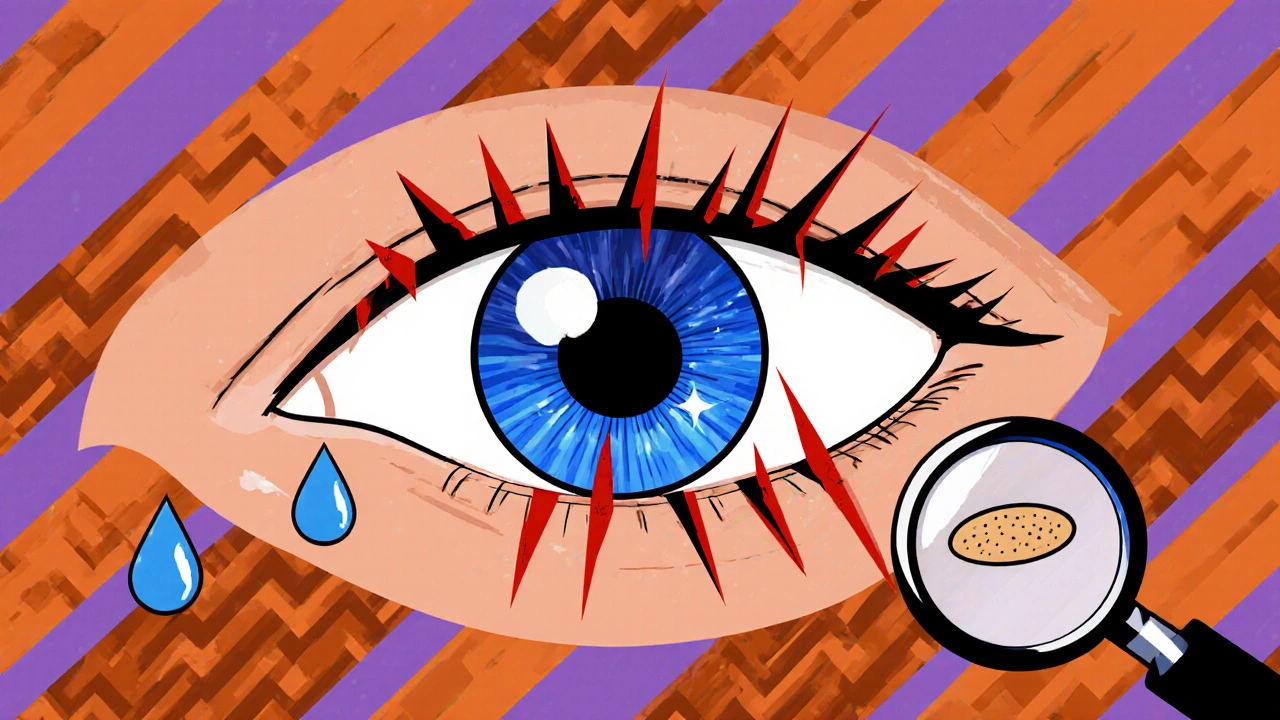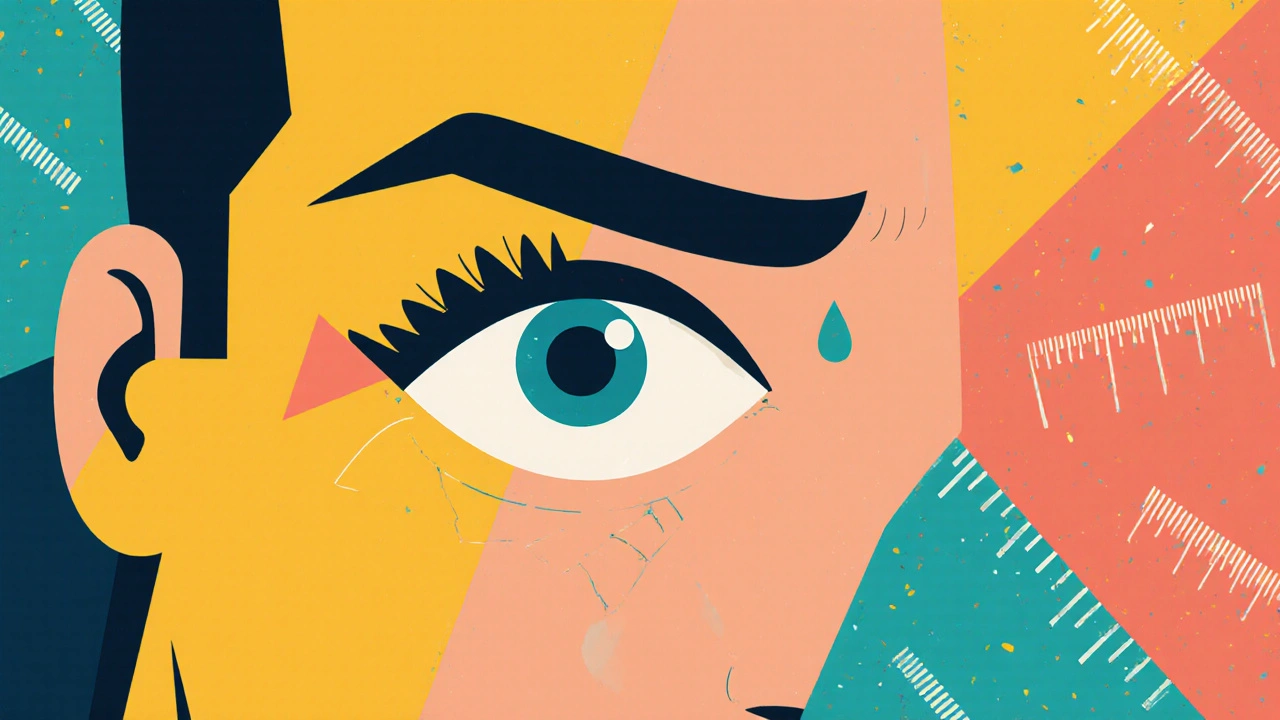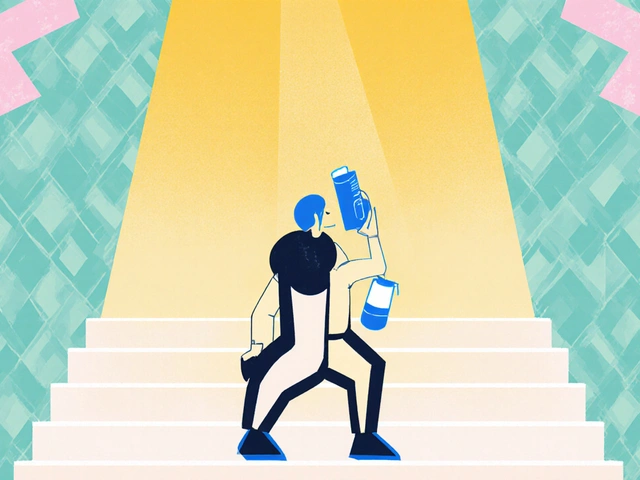When your eyelid starts drooping or your eyelashes rub against your eye, it’s not just annoying-it can affect your vision and even threaten your sight. Two of the most common eyelid disorders, ptosis and entropion, often show up as we age, but they can strike at any age. Many people ignore the early signs, thinking it’s just tired eyes or wrinkles. But these aren’t cosmetic issues. They’re medical conditions that need proper diagnosis and, in many cases, surgical repair.
What Is Ptosis and How Does It Affect You?
Ptosis is when the upper eyelid droops low enough to cover part of the pupil. It can happen in one eye or both. In mild cases, you might just feel like you’re squinting more than usual. In severe cases, you could be struggling to keep your eyes open, leading to eye strain, headaches, or even tilting your head back to see better. The most common cause is aging. As we get older, the levator muscle-the one that lifts your eyelid-stretches and weakens. About 5% of adults over 70 have some degree of ptosis. Other causes include nerve damage, trauma, or congenital factors (present from birth). People who wear contact lenses long-term or frequently rub their eyes are also at higher risk. Doctors measure ptosis using something called the margin reflex distance, or MRD. A normal MRD is 4 to 5 millimeters. If it drops below 3 mm, it’s considered severe. Mild ptosis shows a droop of 1 to 2 mm, moderate is 2 to 3 mm.What Is Entropion and Why It’s Dangerous
Entropion is the opposite problem: your eyelid turns inward. Most often, it’s the lower eyelid that flips, causing your eyelashes to scrape against the cornea-the clear front surface of your eye. This isn’t just uncomfortable. It’s dangerous. That constant rubbing leads to irritation, redness, tearing, and mucus buildup. Over time, it can cause corneal abrasions, ulcers, and even permanent vision loss. The most common type is involutional entropion, which accounts for about 80% of cases in Western countries. It’s caused by loose eyelid tissues and weakened muscles due to aging. Other types include cicatricial entropion (from scarring due to burns, infections like trachoma, or previous surgeries), acute spastic entropion (temporary, caused by inflammation), and rare congenital cases. Trachoma, a bacterial infection from poor sanitation, is still a leading cause of entropion in parts of Africa and Asia. You’ll know you have it if you feel like there’s sand in your eye, even when there isn’t. The discomfort usually gets worse throughout the day. If you’ve had eyelid surgery before, your risk goes up by 40 to 60%.How Are These Conditions Diagnosed?
A simple eye exam can spot both ptosis and entropion. Your doctor will check your eyelid position, measure the MRD, and look for signs of corneal damage. They might use a phenylephrine eye drop test to see how your eyelid responds to stimulation-this helps determine if a specific surgery will work. They’ll also check for related problems like blepharitis (inflamed eyelid margins), ocular rosacea (a chronic inflammation that causes burning and blurred vision), or trichiasis (misdirected eyelashes growing inward). These often coexist and make symptoms worse. If you’ve noticed sudden drooping of your eyelid, especially if it happened over days or weeks, that’s a red flag. Rapid onset can signal nerve problems, like a stroke or aneurysm. That’s not something to wait on.Surgical Repair for Ptosis: What’s Involved
Surgery is the only permanent fix for ptosis. There are three main procedures, chosen based on how strong your levator muscle still is:- Levator resection: Used for moderate to severe ptosis when the levator muscle still has some strength (more than 4 mm of movement). The surgeon shortens the muscle to lift the lid. Success rates are 85-95% for first-time surgeries.
- Frontalis sling: Used when the levator muscle is very weak (less than 4 mm movement). The eyelid is attached to the forehead muscle using a synthetic or biological material. This lets you lift your eyelid by raising your eyebrows. Common in children with congenital ptosis.
- Müller’s muscle-conjunctival resection: For mild ptosis with good response to phenylephrine. It’s less invasive and works well for patients who don’t need major lifting.

Surgical Repair for Entropion: Fixing the Inward Turn
Entropion surgery aims to reposition the eyelid so it sits normally against the eye. The method depends on the cause:- Tarsal fracture procedure: The most common fix for involutional entropion. The surgeon tightens the eyelid by making a small cut and reattaching the muscle. Success rate: 90-95%.
- Tarsal wedge resection: Used for cicatricial entropion caused by scarring. A small wedge of tissue is removed to pull the lid outward.
- Quickert sutures: A temporary fix using stitches to flip the lid outward. Only about 60-70% effective and lasts a few months. Sometimes used to test if surgery will help before committing.
What About Conservative Treatments?
Surgery is usually the end goal, but not always the first step. For mild cases or if you’re not ready for surgery, you can try:- Lubricating eye drops or ointments to reduce corneal irritation from entropion.
- Taping the eyelid at night to hold it in place-helps with both ptosis and entropion.
- Warm compresses and eyelid scrubs for blepharitis, which often makes both conditions worse.
- Epilation or laser treatment for trichiasis-removing misdirected lashes temporarily.
Who Needs Surgery-and When?
You don’t need surgery just because you have a droopy lid. But if:- Your vision is blocked, even slightly
- You’re constantly straining to keep your eyes open
- Your eyelashes are scratching your eye
- You have redness, pain, or signs of corneal damage
What Happens After Surgery?
Recovery is usually quick. Swelling and bruising last about a week. You’ll be told to avoid heavy lifting, bending over, or getting water in your eyes for a few days. Most people return to normal activities within 10 days. You’ll need follow-up visits to check healing and eyelid position. If you had adjustable sutures, you might have one quick adjustment in the office the same day. Long-term, keep up with eyelid hygiene. Blepharitis doesn’t go away-it needs daily cleaning. Use warm compresses and gentle cleansers. If you have ocular rosacea, your doctor may prescribe long-term anti-inflammatory drops.Can You Prevent These Conditions?
You can’t stop aging, but you can reduce your risk:- Avoid rubbing your eyes-this stretches eyelid tissues.
- Wear sunglasses to protect against UV damage that weakens skin.
- Treat blepharitis early with regular lid hygiene.
- Manage conditions like rosacea and dry eye.
- If you’ve had eye surgery before, monitor your eyelid position closely.
When to See a Doctor
Don’t wait until your vision is blocked. Make an appointment if you notice:- One or both eyelids drooping more than before
- Constant feeling of something in your eye
- Redness, tearing, or mucus buildup that won’t go away
- Difficulty reading or driving because your eyelid covers your vision
- Rapid onset of eyelid changes (within days)
Can ptosis go away on its own?
No, ptosis does not resolve on its own. Once the eyelid muscle weakens or stretches, it won’t tighten back up. While temporary drooping can happen after eye surgery or injury, persistent ptosis requires surgical correction. Ignoring it can lead to eye strain, headaches, or even lazy eye in children.
Is entropion surgery painful?
The surgery itself is done under local anesthesia with sedation, so you won’t feel pain during the procedure. Afterward, you may have mild discomfort, swelling, or bruising for a few days. Most patients manage this with over-the-counter pain relievers. The discomfort from the eyelashes rubbing against your eye before surgery is usually far worse than the recovery.
Can I wear contact lenses after eyelid surgery?
You’ll need to avoid contact lenses for at least 1-2 weeks after surgery, sometimes longer if your eye is still healing or dry. Your surgeon will give you a timeline based on your recovery. Wearing contacts too soon can irritate the eye and delay healing.
What’s the difference between entropion and ectropion?
Entropion is when the eyelid turns inward, causing lashes to rub the eye. Ectropion is the opposite-the eyelid turns outward, exposing the eye and leading to dryness and irritation. Both are common in older adults, but they require different surgical fixes. Ectropion often needs skin tightening or grafts, while entropion focuses on tightening the eyelid margin.
Are there non-surgical alternatives for severe ptosis?
For severe ptosis, non-surgical options are limited. Eyeglasses with special crutches to hold up the eyelid exist but are uncomfortable and not reliable. Botox injections are not used for ptosis-they can actually make it worse. Surgery remains the only effective long-term solution for significant drooping that affects vision or quality of life.





prasad gaude
November 25, 2025 AT 14:55Back in my village in Rajasthan, we used to rub turmeric paste on eyelids if someone had drooping - thought it was 'bad air' entering the body. Funny how modern medicine now says the same thing: muscles weaken, tissues sag. But we didn't have surgeons, just grandmas with herbal wisdom. Still, it's wild how much we still don't know about the body - even when you're staring at your own eyelid wondering if it's aging or a stroke.
giselle kate
November 26, 2025 AT 04:55Why are we even talking about this like it's some exotic medical mystery? America spends billions on cosmetic eyelid lifts while people in India still go blind from trachoma because they can't afford basic antibiotics. This isn't about 'aging' - it's about who gets care and who gets ignored. If you're rich, you get adjustable sutures. If you're poor, you get a scratched cornea and a prayer.
Leisha Haynes
November 27, 2025 AT 20:34So basically if your eyelid starts acting up you're either old or you rub your eyes like a toddler with a stuffed animal 🤦♀️ no wonder we all look like we’ve been crying since 2017
Roscoe Howard
November 28, 2025 AT 03:37It is imperative to underscore that the pathological etiology of ptosis and entropion, while frequently attributed to senescent degeneration, is often exacerbated by non-compliance with ocular hygiene protocols, which, in the context of American healthcare, reflects a broader societal trend of neglect toward preventive medicine. Furthermore, the proliferation of contact lens usage without adequate sterilization procedures has demonstrably increased the incidence of mechanical trauma to the tarsal plate.
Lisa Odence
November 29, 2025 AT 04:56Okay but have you seen the new minimally invasive techniques?? 🤯 Like, absorbable sutures?? No more 6-week recovery?? I had mine done last year and I was back to scrolling TikTok in 9 days!! 🙌 Also, please please please use warm compresses daily - your eyelids will thank you 😘💧 #eyelidhealth #surgerywasworthit
Pallab Dasgupta
November 30, 2025 AT 02:48Bro, I saw my uncle in Kerala go blind from entropion because he thought it was just 'eye fatigue' - he waited 3 years. When he finally went to the doctor, the cornea was scarred. Surgery saved his sight, but not his joy. This isn't just about eyelids - it's about listening to your body before it screams. Don't be like my uncle. Check your eyes. Now.
Ellen Sales
November 30, 2025 AT 07:13I think people underestimate how much emotional labor goes into living with ptosis - you're constantly adjusting your head, feeling like you're squinting at the world, like you're trying to see through a fogged-up window… and then someone says 'you look tired' like it's a personality flaw. It's not. It's biology. And yes, surgery fixed it - but the emotional weight? That took longer to heal.
Andrew Camacho
December 2, 2025 AT 02:13Let’s be real - this whole post is just a glorified ad for oculoplastic surgeons. $2.7 billion market? Yeah, because people are being scared into surgery like it’s a luxury spa treatment. I’ve seen people with mild ptosis get full frontalis slings because the doc wanted to 'maximize revenue'. Meanwhile, 80% of cases could be managed with taping and lubricants. Stop the fear-mongering.
Emily Craig
December 3, 2025 AT 15:10So you're telling me I've been squinting at my phone for 10 years and now my eyelid is like 'nah, I'm done'?? 😭 I thought I was just tired - turns out I needed a surgeon, not a nap
Shirou Spade
December 4, 2025 AT 11:55In Hindu philosophy, the eyes are the windows of the soul - but what happens when the window frame cracks? We don't fix the frame, we just paint over it. Modern medicine fixes the lid. But the soul still wonders: why did we wait so long? Why did we ignore the signs until it hurt? Maybe healing isn't just in the scalpels - maybe it's in the listening.
fiona collins
December 4, 2025 AT 22:47Thanks for the clear info. I’ve had mild ptosis since my 40s. Taping at night helped. Surgery? Maybe next year. No rush. But I’m watching it.
Amy Hutchinson
December 5, 2025 AT 12:48OMG I had entropion and I just kept putting in eye drops like it was a magic potion. My mom finally dragged me to the doc and I cried because I thought I was gonna lose my eye 😭 surgery was easy. Now I wear sunglasses even indoors. I’m basically a vampire now.
Erika Hunt
December 5, 2025 AT 14:23It's fascinating, isn't it, how the human body, despite its incredible resilience, is so vulnerable to the slow, silent erosion of time - and yet, we treat these changes as if they're merely aesthetic inconveniences, rather than physiological signals that something deeper is shifting? The levator muscle, once strong and responsive, becomes lax - not because we've 'aged poorly,' but because we've lived, blinked, rubbed, stared, cried, and slept too little for decades. And now, in our era of instant fixes and surgical marketing, we're being sold a solution before we've even asked the right questions. Is it really about vision? Or is it about identity - about seeing yourself in the mirror without the weight of a drooping lid? And if we could just pause, breathe, and listen - would we even need the scalpel at all?
Josh Zubkoff
December 5, 2025 AT 19:08Okay but who wrote this? It reads like a pharmaceutical sales pitch disguised as a medical guide. 'New adjustable sutures reduce revision surgery by 25%' - wow, groundbreaking. And the 'global market hitting $2.7 billion'? That’s not a fact - that’s a marketing KPI. This whole thing feels like someone got paid to make eyelid surgery sound like the most urgent thing since antibiotics. Meanwhile, people are going blind from neglected trachoma in 2025 and we’re talking about whether your eyelid is 1.2mm too low. Priorities.